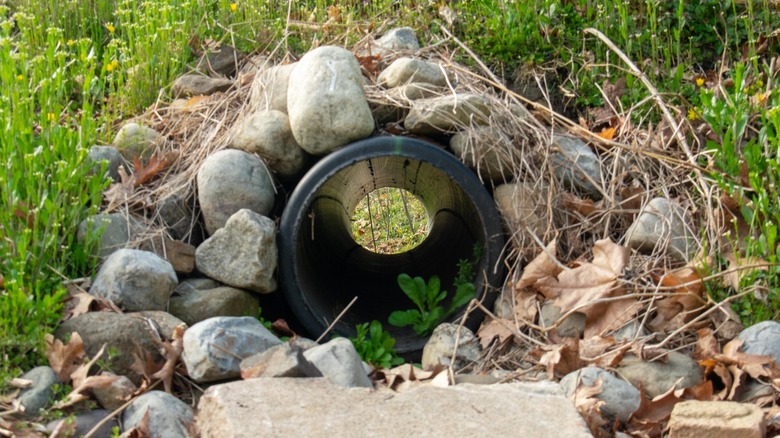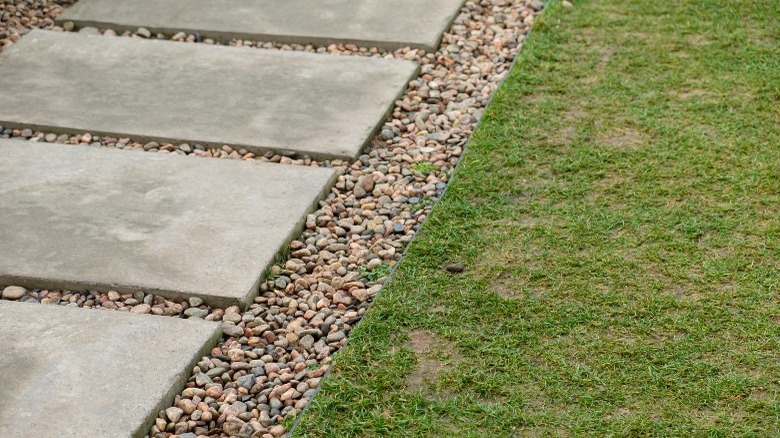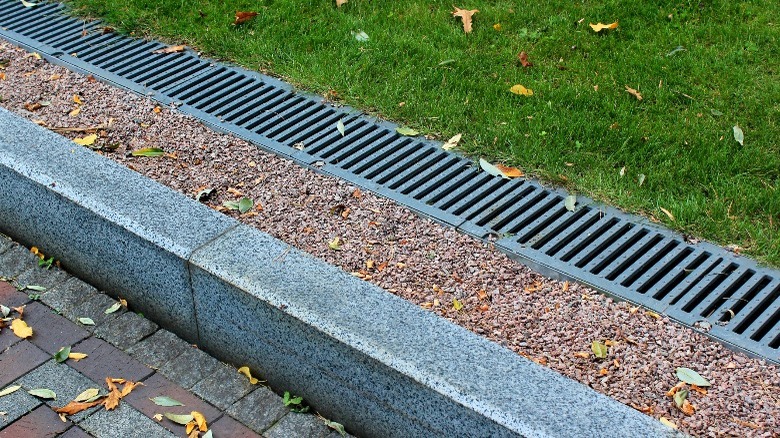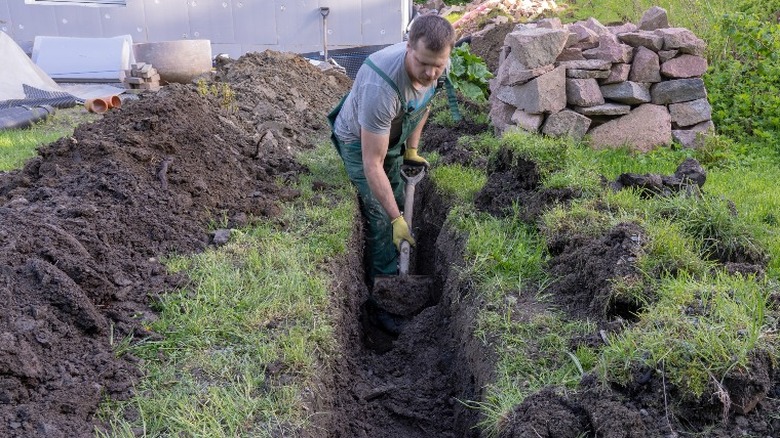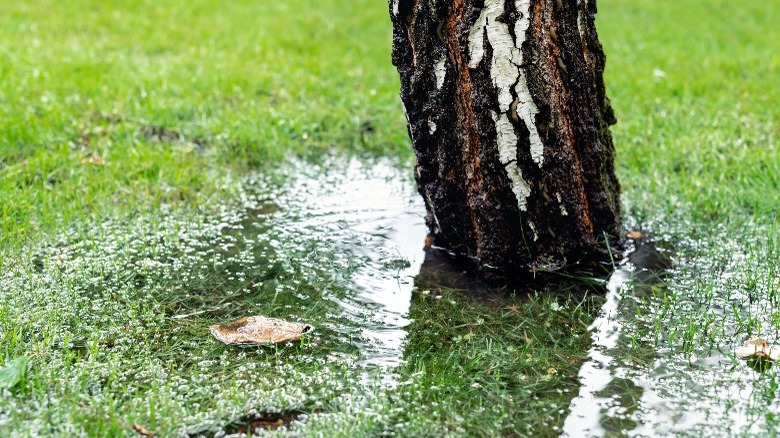What Is A French Drain And Do You Need One?
A French drain is a strategically placed ditch that diverts surface and ground water from one area to another. They are most often built around building structures or foundations to protect them from water damage. Though the name implies some sort of connection to France, you may be surprised to learn that the French drain was named for a man rather than after the country. According to The Washington Post, the French drain was popularized by Henry Flagg French, a lawyer from Massachusetts who wrote about the invention in his 1859 book, "Farm Drainage."
Over a century later, the invention was installed to protect the base of the Lincoln Memorial, the statue created by French's son, artist Daniel Chester French! More than just a fun historical coincidence, this anecdote demonstrates how the French drain has maintained its relevance through decades of industrial and technological progress. From large projects to small, the French drain serves an important function in preserving infrastructure to keep things safe and efficient. Read on to discover even more about French drains, and find out if one is the right solution for your own drainage problems.
How does a French drain work?
A French drain is a relatively simple invention, comprised of just a few parts. It functions similarly to a roof gutter in order to manage the flow of water at the ground level. As Bob Vila explains, a French drain describes a slightly angled trench dug into the ground, deep enough to fit an underground pipe with small perforations throughout. The rest of the trench is filled with gravel to completely cover the pipe. The trench collects water, while the gravel within is permeable to allow water to filter through the ground to the pipe. During installation, the pipe is laid in ground at a slightly sloped angle following that of the trench, with the lower end placed wherever you are trying to direct the flow of excess water to. This is key, as a level or incorrectly angled pipe may not provide adequate drainage.
While an angled trench alone could gather and divert excess water, an open ditch in the ground could be a significant safety hazard, especially in the dark of night. They work well enough along stretches of highway, but close to a building a more sophisticated solution is needed, hence the widespread implementation of French drains around both commercial and residential buildings. French drains also provide an aesthetic function. Included as a feature of their design, they hide any unsightly pipes or exposed ground, and can be subtlety incorporated into surrounding landscape without major disruption.
Types of French drains
Since it's initial introduction, a few variations on the traditional French drain have been developed. In a traditional French drain, the layer of gravel that covers the pipe is filled to ground level so that it is visible. A curtain drain is essentially the same, except that the gravel does not extend to the surface and is instead covered with soil so that vegetation can grow over top. This variation is ideal for any homeowners who wish to preserve their landscaping and conceal their French drain from sight.
According to Lawn and Landcare, collector or interceptor drains are used to address excess water that pools above ground rather than below. They work similarly to French drains in the sense that they use gravity to direct the water to the intended outlet. A fin drain is often described as a smaller version of a French drain. It includes a "fin" or section of material that extends vertically from the surface to the pipe underground to help divert water. Fin drains tend to be narrower and less intrusive than French drains, and thus less expensive. This variation is a good option for a cost-conscious homeowner with a smaller budget who does not mind part of the drain being visible above ground.
How to install a French drain
The design of a French drain is relatively simple, and there are several online resources for DIY installation. Drainage issues can be rather complicated, so if you are considering installing a French drain yourself, be sure to consult with professionals to determine the best possible solution. Alterations to water flow patterns can have unexpected effects on the surrounding area if the overall site is not properly analyzed by an expert. A professional will be equipped with the right tools and expertise to correctly advise on and/or install a French drain on your property.
To start, plan the location of the pipe and a suitable outlet for the water to drain. Home Depot recommends checking site plans to make sure there are no existing underground power lines or pipes in your intended path. If there are no obstacles, use a shovel or trencher to dig a continuous trench at least 18 inches deep and a foot wide, sloped slightly so that the water flows downward from the affected area to the outlet. Your trench may need to be deeper and wider, depending on your situation. Line the trench with landscaping fabric that will allow water drainage but block excess soil, pests, or roots that could clog the system. Use enough fabric to fold the sides over the top of the pipe in a later step. Pour a few inches of gravel along the bottom of the trench to form a bed for the pipe, maintaining the slope of the trench. Next, install a grate wherever water is pooling, and connect it to the piping that will run the length of the trench to the outlet point. A flexible drainage pipe will be easier to install, but PVC will be more durable. For PVC, drill your drainage holes at least 6 inches apart. When the pipe is installed, the slope should again be maintained and holes faced down. Cover the pipe with more gravel, and then fold the fabric liner over the top. To finish, cover with soil and plant grass seed or lay landscaping stone atop the pipe.
When you need a French drain
A French drain can help solve a number of water-related issues that plague homeowners. It is always best to seek a consultation first, but there are a few scenarios that indicate it may be time to call a professional. Repeated flooding of an underground space such as a basement or cellar is a tell-tale sign of inadequate drainage. Henry Flagg French's extensive research into drainage systems for his 1859 book was catalyzed in part by the chronic flooding of his own farmhouse cellar. As Garden Gate warns, flooding can destroy items you have stored in your basement, and lead to the development of hazardous mold and mildew that can lower the indoor air quality and exacerbate allergies or respiratory illness. Furthermore, if the issue is not addressed, the risk of irreversible structural damage to the building foundation will only increase as the problem persists.
A less serious situation in which you may need a French drain is if you discover excess water pooling in an area of your yard. While your grass may be happy, poor drainage can weaken or kill garden plants that prefer dryer conditions, and standing water can attract insects such as mosquitos that sometimes carry serious diseases. It can also be difficult to navigate, especially for maintenance purposes, and is generally considered an eyesore. A French drain can remedy all these problems and allow you to enjoy your outdoor spaces as intended. A French drain can also be installed to prevent a future problem rather than remedying it. If you are planning to add a retaining wall to your property, it is a good idea to install a French drain as well. This will allow you to drain excess water that might pool at the base of a slope, and control the flow to prevent it from flowing to unwanted areas.

